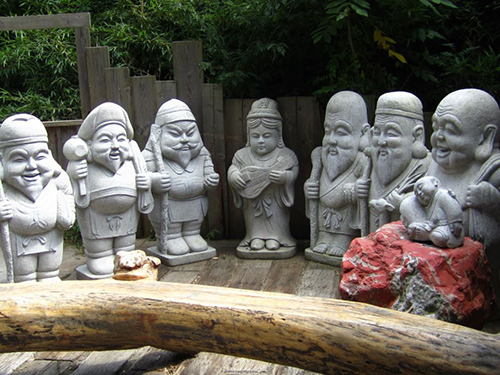128. The "Ear" Radical: 耳
Lend me your ears so I can tell you about 耳, the "ear" radical.
This six-stroke shape, which has no variants, looks identical to the following kanji:
耳 (29: ear, hearing)
That character carries the Joyo kun-yomi みみ, and it follows that the radical name is also みみ. It applies to 耳 (29) itself, as well as to these kanji:
聞 (200: to hear; ask; news)
聖 (911: holy)
When the radical slides to the left side of a kanji, the name みみへん is more fitting:
職 (721: employment, occupation, work, job, post, office; craftsman, artisan; (professional) skill)
聴 (1598: to listen, hear)
The -へん corresponds to -偏, the position name for a radical on the left side of a kanji. (For more on that nomenclature, see Radical Terms and check the "Radical Positions" section.)
Now you've seen all five Joyo kanji featuring an on-duty 耳 radical.

Photo Credit: Corey Linstrom
Near Shosenkyo, a gorge in Kofu City, which is in Yamanashi Prefecture on Honshu, the statues of 七福神 (しちふくじん: Seven Gods of Good Fortune) depict them with enormous ears. This is no caricature. Japanese superstition has it that big ears (whether on deities or humans) represent wealth and luck. This goes back to Buddha, who supposedly had ears that were long, like lotus petals!
What the Ears Do in Kanji
The 耳 shape depicts an ear, according to Henshall in his newer edition. (All etymologies here come from that book.) His analysis helps us understand not only the 耳 kanji but also this one:
聖 (911: holy)
The character combines an "ear" and "mouth" on top with "person standing tall on the ground." That lower component phonetically conveys "pass through" or "hear." These three parts collectively mean "ear cavity is open and able to hear voices of the deities not audible to ordinary people." By extension 聖 came to mean "a sage" or "wise."
Henshall notes that the early shape of 聴 (1598: to listen, hear) essentially matched that of 聖. Ancient forms of 聴 depicted one ear next to one or two mouths, yielding "listen to." Beyond that I can't understand his explanation, so let's instead examine this kanji:
聞 (200: to hear; ask; news)
For some reason, I'm disappointed that this does not symbolize an ear at a gate. Rather, the character originally showed a person holding a hand to an exaggeratedly large ear. The 門 came later, I believe, and is a phonetic with the associated sense "distinguish." Henshall says that "ask" may be a loan usage.
Not every 耳 in a kanji symbolizes an ear. Take this character:
職 (721: employment, occupation, work, job, post, office; craftsman, artisan; (professional) skill)
Just as an ear is attached to and adjacent to the head, this 耳 represents "something attached next to." Henshall calls that an analogy. The rest of the character represents "cut branch/stake thrust into the the ground," so 職 means "flag/banner attached to stake thrust into the ground." In the past, merchants set up banners to indicate the type of business they were running.
Photo Credit: Eve Kushner
In the Ginza section of Tokyo, the lowest restaurant sign shown here contains a literary allusion. That is, 東方見聞録 is not only the name of a now-closed establishment but also the title of a 13th-century work originally in Italian. The book describes Marco Polo's travels through Asia between 1271 and 1295, as well as his experiences at Kublai Khan's court. In English the title became Book of the Marvels of the World, and although I've never heard of this work, it's quite famous in Japan because students learn about it in history class.
Let's return to kanji matters! Here's a breakdown of 東方見聞録:
東方 (とうほう: eastern direction)
見聞 (けんぶん: experience)
録 (ろく: record)
Literally, 見聞 represents what is seen (見) and heard (聞)!
